ARBE3308: BIM Implementation Plan for NewSpace, Newcastle University
VerifiedAdded on 2022/08/26
|9
|2944
|15
Report
AI Summary
This report provides a comprehensive BIM implementation plan for the 'NewSpace' university campus project in Newcastle, modeled on the AIA CA BIM Management Plans. It outlines information management principles using a database system based on BIM and the Industry Foundation Classes (IFC) format, with Autodesk Revit TM as the selected software. The plan emphasizes stakeholder collaboration, detailing steps for buy-in, software selection, and file format standardization. It presents a project management execution strategy, encompassing goal setting, staff training, BIM feature customization, and continuous improvement. The plan follows AIA documents and protocols for digital data usage, defining data types, transmission protocols, and modeling protocols. The BIM implementation plan includes the setting of goals, staff training, BIM customization, and continuous improvements to ensure effective collaboration and lifecycle management of the building.

BUILDING INFORMATION MODELLING IMPLEMENTATION
PLAN
PLAN
Paraphrase This Document
Need a fresh take? Get an instant paraphrase of this document with our AI Paraphraser
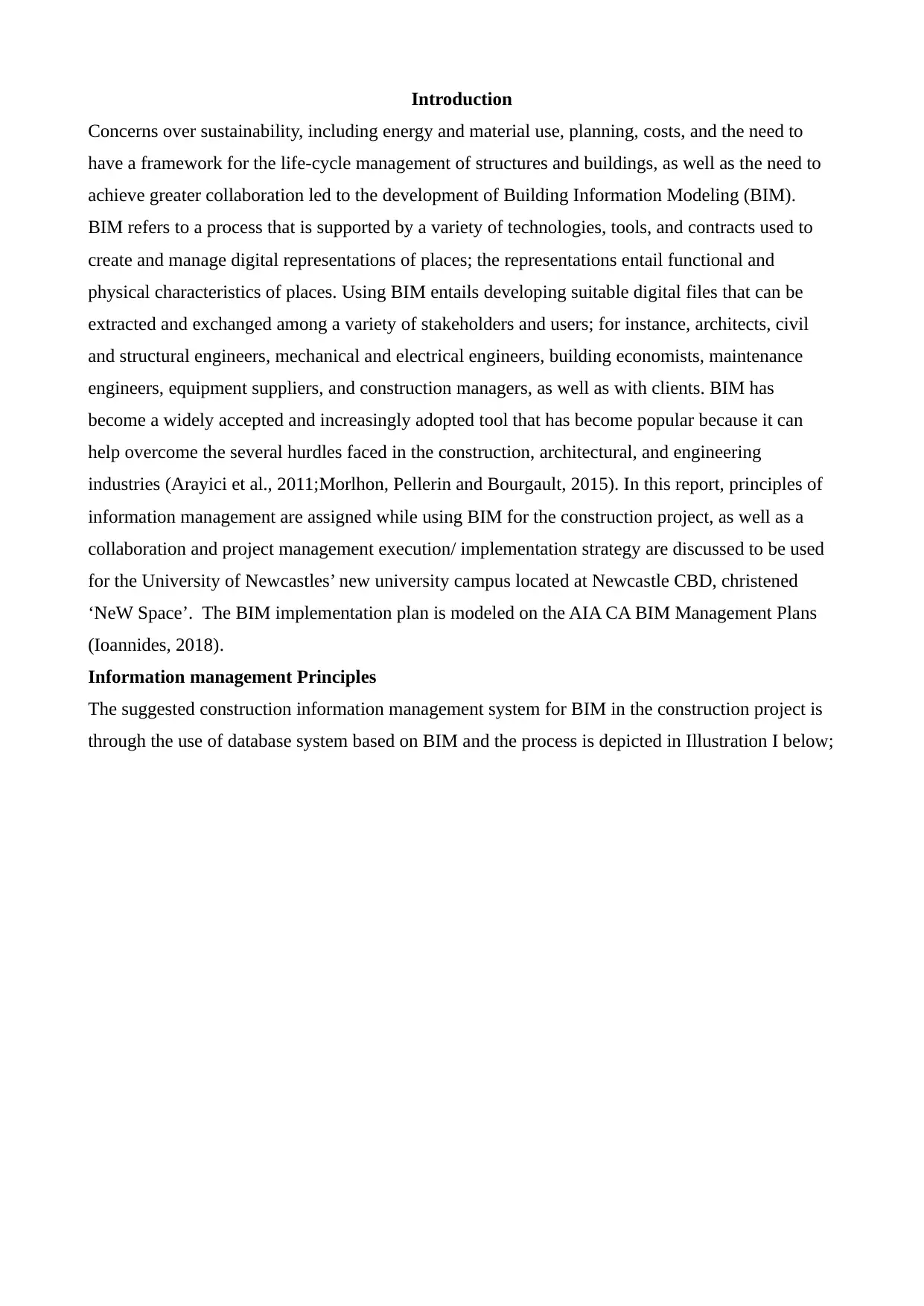
Introduction
Concerns over sustainability, including energy and material use, planning, costs, and the need to
have a framework for the life-cycle management of structures and buildings, as well as the need to
achieve greater collaboration led to the development of Building Information Modeling (BIM).
BIM refers to a process that is supported by a variety of technologies, tools, and contracts used to
create and manage digital representations of places; the representations entail functional and
physical characteristics of places. Using BIM entails developing suitable digital files that can be
extracted and exchanged among a variety of stakeholders and users; for instance, architects, civil
and structural engineers, mechanical and electrical engineers, building economists, maintenance
engineers, equipment suppliers, and construction managers, as well as with clients. BIM has
become a widely accepted and increasingly adopted tool that has become popular because it can
help overcome the several hurdles faced in the construction, architectural, and engineering
industries (Arayici et al., 2011;Morlhon, Pellerin and Bourgault, 2015). In this report, principles of
information management are assigned while using BIM for the construction project, as well as a
collaboration and project management execution/ implementation strategy are discussed to be used
for the University of Newcastles’ new university campus located at Newcastle CBD, christened
‘NeW Space’. The BIM implementation plan is modeled on the AIA CA BIM Management Plans
(Ioannides, 2018).
Information management Principles
The suggested construction information management system for BIM in the construction project is
through the use of database system based on BIM and the process is depicted in Illustration I below;
Concerns over sustainability, including energy and material use, planning, costs, and the need to
have a framework for the life-cycle management of structures and buildings, as well as the need to
achieve greater collaboration led to the development of Building Information Modeling (BIM).
BIM refers to a process that is supported by a variety of technologies, tools, and contracts used to
create and manage digital representations of places; the representations entail functional and
physical characteristics of places. Using BIM entails developing suitable digital files that can be
extracted and exchanged among a variety of stakeholders and users; for instance, architects, civil
and structural engineers, mechanical and electrical engineers, building economists, maintenance
engineers, equipment suppliers, and construction managers, as well as with clients. BIM has
become a widely accepted and increasingly adopted tool that has become popular because it can
help overcome the several hurdles faced in the construction, architectural, and engineering
industries (Arayici et al., 2011;Morlhon, Pellerin and Bourgault, 2015). In this report, principles of
information management are assigned while using BIM for the construction project, as well as a
collaboration and project management execution/ implementation strategy are discussed to be used
for the University of Newcastles’ new university campus located at Newcastle CBD, christened
‘NeW Space’. The BIM implementation plan is modeled on the AIA CA BIM Management Plans
(Ioannides, 2018).
Information management Principles
The suggested construction information management system for BIM in the construction project is
through the use of database system based on BIM and the process is depicted in Illustration I below;
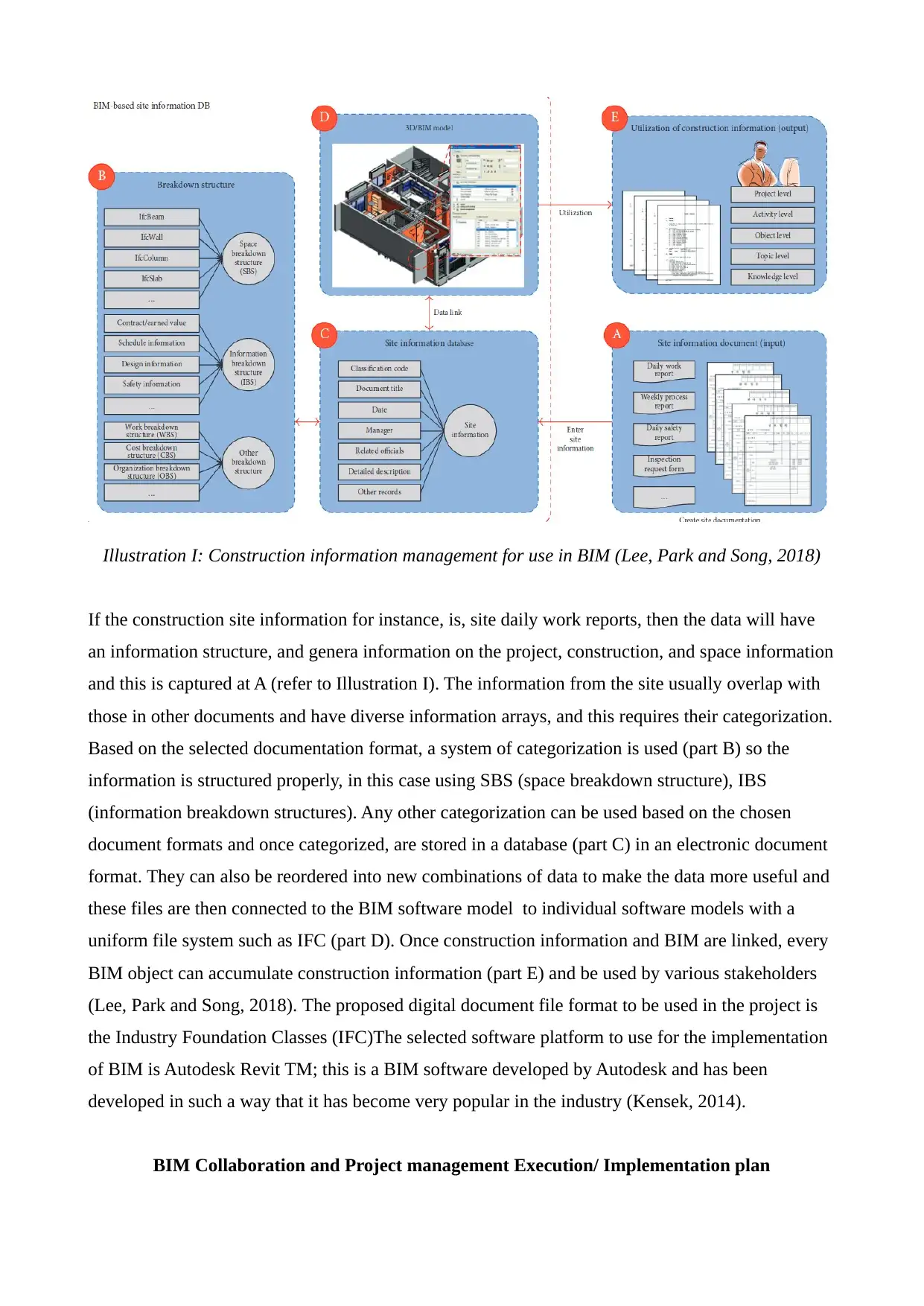
If the construction site information for instance, is, site daily work reports, then the data will have
an information structure, and genera information on the project, construction, and space information
and this is captured at A (refer to Illustration I). The information from the site usually overlap with
those in other documents and have diverse information arrays, and this requires their categorization.
Based on the selected documentation format, a system of categorization is used (part B) so the
information is structured properly, in this case using SBS (space breakdown structure), IBS
(information breakdown structures). Any other categorization can be used based on the chosen
document formats and once categorized, are stored in a database (part C) in an electronic document
format. They can also be reordered into new combinations of data to make the data more useful and
these files are then connected to the BIM software model to individual software models with a
uniform file system such as IFC (part D). Once construction information and BIM are linked, every
BIM object can accumulate construction information (part E) and be used by various stakeholders
(Lee, Park and Song, 2018). The proposed digital document file format to be used in the project is
the Industry Foundation Classes (IFC)The selected software platform to use for the implementation
of BIM is Autodesk Revit TM; this is a BIM software developed by Autodesk and has been
developed in such a way that it has become very popular in the industry (Kensek, 2014).
BIM Collaboration and Project management Execution/ Implementation plan
Illustration I: Construction information management for use in BIM (Lee, Park and Song, 2018)
an information structure, and genera information on the project, construction, and space information
and this is captured at A (refer to Illustration I). The information from the site usually overlap with
those in other documents and have diverse information arrays, and this requires their categorization.
Based on the selected documentation format, a system of categorization is used (part B) so the
information is structured properly, in this case using SBS (space breakdown structure), IBS
(information breakdown structures). Any other categorization can be used based on the chosen
document formats and once categorized, are stored in a database (part C) in an electronic document
format. They can also be reordered into new combinations of data to make the data more useful and
these files are then connected to the BIM software model to individual software models with a
uniform file system such as IFC (part D). Once construction information and BIM are linked, every
BIM object can accumulate construction information (part E) and be used by various stakeholders
(Lee, Park and Song, 2018). The proposed digital document file format to be used in the project is
the Industry Foundation Classes (IFC)The selected software platform to use for the implementation
of BIM is Autodesk Revit TM; this is a BIM software developed by Autodesk and has been
developed in such a way that it has become very popular in the industry (Kensek, 2014).
BIM Collaboration and Project management Execution/ Implementation plan
Illustration I: Construction information management for use in BIM (Lee, Park and Song, 2018)
⊘ This is a preview!⊘
Do you want full access?
Subscribe today to unlock all pages.

Trusted by 1+ million students worldwide
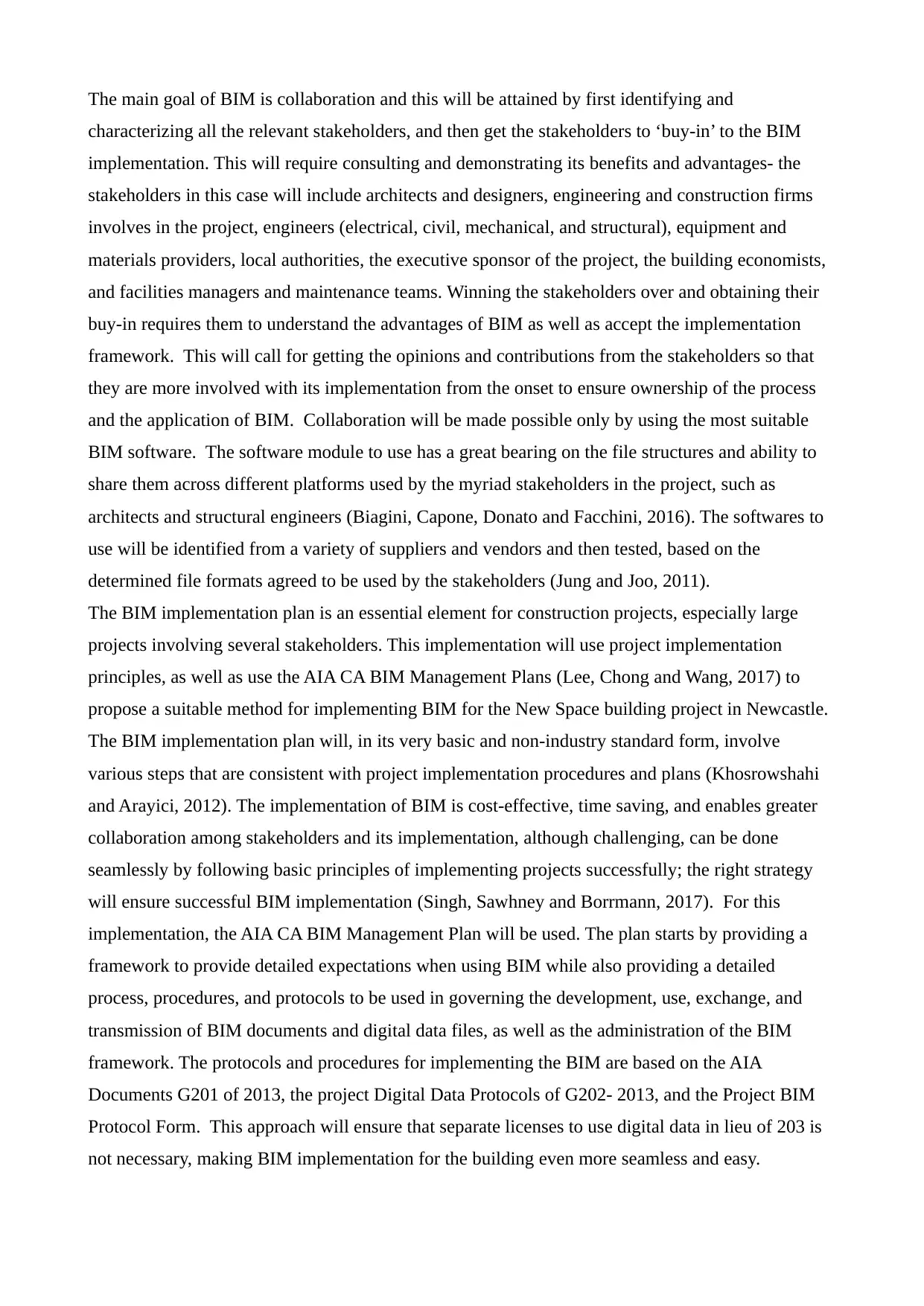
The main goal of BIM is collaboration and this will be attained by first identifying and
characterizing all the relevant stakeholders, and then get the stakeholders to ‘buy-in’ to the BIM
implementation. This will require consulting and demonstrating its benefits and advantages- the
stakeholders in this case will include architects and designers, engineering and construction firms
involves in the project, engineers (electrical, civil, mechanical, and structural), equipment and
materials providers, local authorities, the executive sponsor of the project, the building economists,
and facilities managers and maintenance teams. Winning the stakeholders over and obtaining their
buy-in requires them to understand the advantages of BIM as well as accept the implementation
framework. This will call for getting the opinions and contributions from the stakeholders so that
they are more involved with its implementation from the onset to ensure ownership of the process
and the application of BIM. Collaboration will be made possible only by using the most suitable
BIM software. The software module to use has a great bearing on the file structures and ability to
share them across different platforms used by the myriad stakeholders in the project, such as
architects and structural engineers (Biagini, Capone, Donato and Facchini, 2016). The softwares to
use will be identified from a variety of suppliers and vendors and then tested, based on the
determined file formats agreed to be used by the stakeholders (Jung and Joo, 2011).
The BIM implementation plan is an essential element for construction projects, especially large
projects involving several stakeholders. This implementation will use project implementation
principles, as well as use the AIA CA BIM Management Plans (Lee, Chong and Wang, 2017) to
propose a suitable method for implementing BIM for the New Space building project in Newcastle.
The BIM implementation plan will, in its very basic and non-industry standard form, involve
various steps that are consistent with project implementation procedures and plans (Khosrowshahi
and Arayici, 2012). The implementation of BIM is cost-effective, time saving, and enables greater
collaboration among stakeholders and its implementation, although challenging, can be done
seamlessly by following basic principles of implementing projects successfully; the right strategy
will ensure successful BIM implementation (Singh, Sawhney and Borrmann, 2017). For this
implementation, the AIA CA BIM Management Plan will be used. The plan starts by providing a
framework to provide detailed expectations when using BIM while also providing a detailed
process, procedures, and protocols to be used in governing the development, use, exchange, and
transmission of BIM documents and digital data files, as well as the administration of the BIM
framework. The protocols and procedures for implementing the BIM are based on the AIA
Documents G201 of 2013, the project Digital Data Protocols of G202- 2013, and the Project BIM
Protocol Form. This approach will ensure that separate licenses to use digital data in lieu of 203 is
not necessary, making BIM implementation for the building even more seamless and easy.
characterizing all the relevant stakeholders, and then get the stakeholders to ‘buy-in’ to the BIM
implementation. This will require consulting and demonstrating its benefits and advantages- the
stakeholders in this case will include architects and designers, engineering and construction firms
involves in the project, engineers (electrical, civil, mechanical, and structural), equipment and
materials providers, local authorities, the executive sponsor of the project, the building economists,
and facilities managers and maintenance teams. Winning the stakeholders over and obtaining their
buy-in requires them to understand the advantages of BIM as well as accept the implementation
framework. This will call for getting the opinions and contributions from the stakeholders so that
they are more involved with its implementation from the onset to ensure ownership of the process
and the application of BIM. Collaboration will be made possible only by using the most suitable
BIM software. The software module to use has a great bearing on the file structures and ability to
share them across different platforms used by the myriad stakeholders in the project, such as
architects and structural engineers (Biagini, Capone, Donato and Facchini, 2016). The softwares to
use will be identified from a variety of suppliers and vendors and then tested, based on the
determined file formats agreed to be used by the stakeholders (Jung and Joo, 2011).
The BIM implementation plan is an essential element for construction projects, especially large
projects involving several stakeholders. This implementation will use project implementation
principles, as well as use the AIA CA BIM Management Plans (Lee, Chong and Wang, 2017) to
propose a suitable method for implementing BIM for the New Space building project in Newcastle.
The BIM implementation plan will, in its very basic and non-industry standard form, involve
various steps that are consistent with project implementation procedures and plans (Khosrowshahi
and Arayici, 2012). The implementation of BIM is cost-effective, time saving, and enables greater
collaboration among stakeholders and its implementation, although challenging, can be done
seamlessly by following basic principles of implementing projects successfully; the right strategy
will ensure successful BIM implementation (Singh, Sawhney and Borrmann, 2017). For this
implementation, the AIA CA BIM Management Plan will be used. The plan starts by providing a
framework to provide detailed expectations when using BIM while also providing a detailed
process, procedures, and protocols to be used in governing the development, use, exchange, and
transmission of BIM documents and digital data files, as well as the administration of the BIM
framework. The protocols and procedures for implementing the BIM are based on the AIA
Documents G201 of 2013, the project Digital Data Protocols of G202- 2013, and the Project BIM
Protocol Form. This approach will ensure that separate licenses to use digital data in lieu of 203 is
not necessary, making BIM implementation for the building even more seamless and easy.
Paraphrase This Document
Need a fresh take? Get an instant paraphrase of this document with our AI Paraphraser
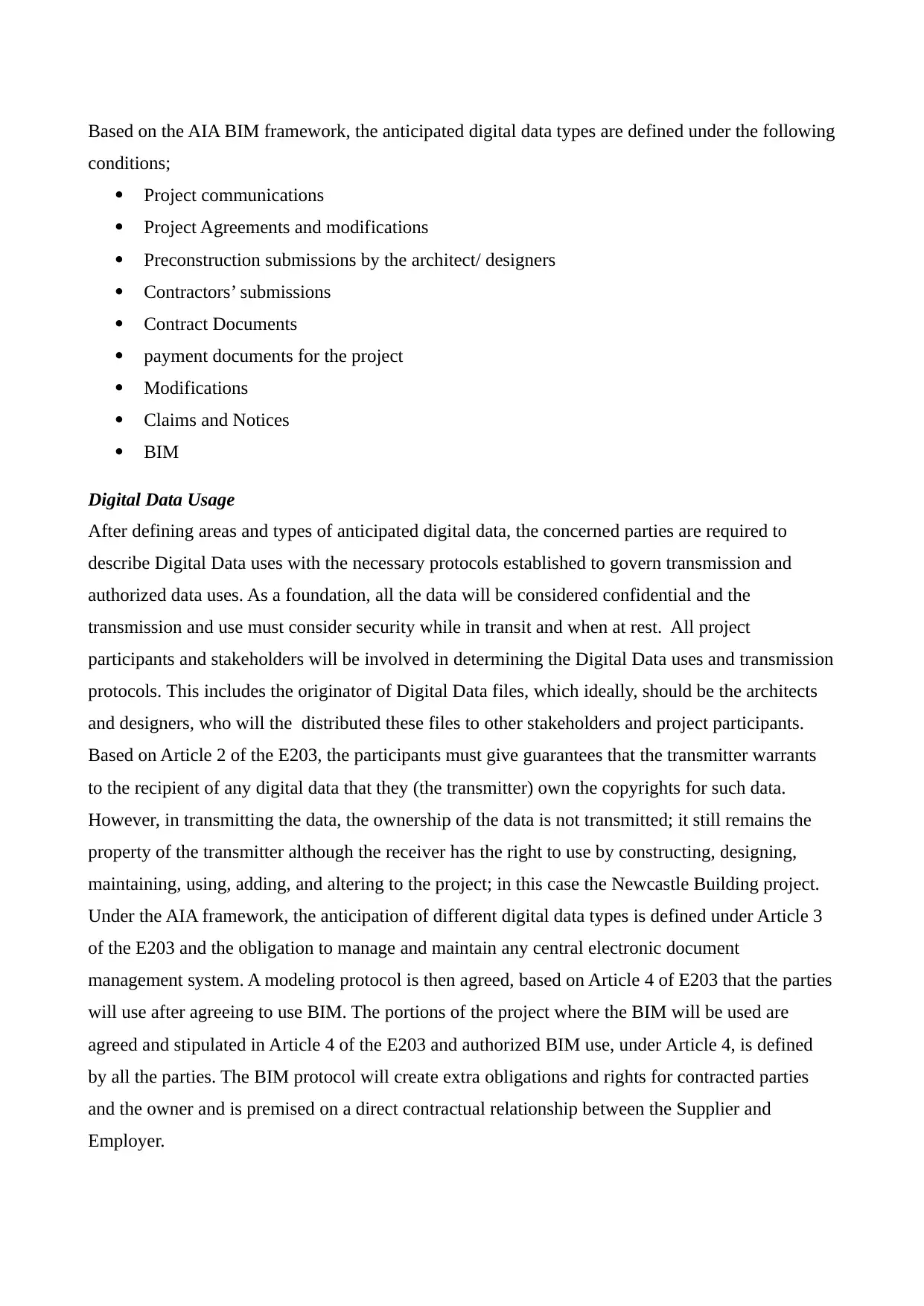
Based on the AIA BIM framework, the anticipated digital data types are defined under the following
conditions;
Project communications
Project Agreements and modifications
Preconstruction submissions by the architect/ designers
Contractors’ submissions
Contract Documents
payment documents for the project
Modifications
Claims and Notices
BIM
Digital Data Usage
After defining areas and types of anticipated digital data, the concerned parties are required to
describe Digital Data uses with the necessary protocols established to govern transmission and
authorized data uses. As a foundation, all the data will be considered confidential and the
transmission and use must consider security while in transit and when at rest. All project
participants and stakeholders will be involved in determining the Digital Data uses and transmission
protocols. This includes the originator of Digital Data files, which ideally, should be the architects
and designers, who will the distributed these files to other stakeholders and project participants.
Based on Article 2 of the E203, the participants must give guarantees that the transmitter warrants
to the recipient of any digital data that they (the transmitter) own the copyrights for such data.
However, in transmitting the data, the ownership of the data is not transmitted; it still remains the
property of the transmitter although the receiver has the right to use by constructing, designing,
maintaining, using, adding, and altering to the project; in this case the Newcastle Building project.
Under the AIA framework, the anticipation of different digital data types is defined under Article 3
of the E203 and the obligation to manage and maintain any central electronic document
management system. A modeling protocol is then agreed, based on Article 4 of E203 that the parties
will use after agreeing to use BIM. The portions of the project where the BIM will be used are
agreed and stipulated in Article 4 of the E203 and authorized BIM use, under Article 4, is defined
by all the parties. The BIM protocol will create extra obligations and rights for contracted parties
and the owner and is premised on a direct contractual relationship between the Supplier and
Employer.
conditions;
Project communications
Project Agreements and modifications
Preconstruction submissions by the architect/ designers
Contractors’ submissions
Contract Documents
payment documents for the project
Modifications
Claims and Notices
BIM
Digital Data Usage
After defining areas and types of anticipated digital data, the concerned parties are required to
describe Digital Data uses with the necessary protocols established to govern transmission and
authorized data uses. As a foundation, all the data will be considered confidential and the
transmission and use must consider security while in transit and when at rest. All project
participants and stakeholders will be involved in determining the Digital Data uses and transmission
protocols. This includes the originator of Digital Data files, which ideally, should be the architects
and designers, who will the distributed these files to other stakeholders and project participants.
Based on Article 2 of the E203, the participants must give guarantees that the transmitter warrants
to the recipient of any digital data that they (the transmitter) own the copyrights for such data.
However, in transmitting the data, the ownership of the data is not transmitted; it still remains the
property of the transmitter although the receiver has the right to use by constructing, designing,
maintaining, using, adding, and altering to the project; in this case the Newcastle Building project.
Under the AIA framework, the anticipation of different digital data types is defined under Article 3
of the E203 and the obligation to manage and maintain any central electronic document
management system. A modeling protocol is then agreed, based on Article 4 of E203 that the parties
will use after agreeing to use BIM. The portions of the project where the BIM will be used are
agreed and stipulated in Article 4 of the E203 and authorized BIM use, under Article 4, is defined
by all the parties. The BIM protocol will create extra obligations and rights for contracted parties
and the owner and is premised on a direct contractual relationship between the Supplier and
Employer.
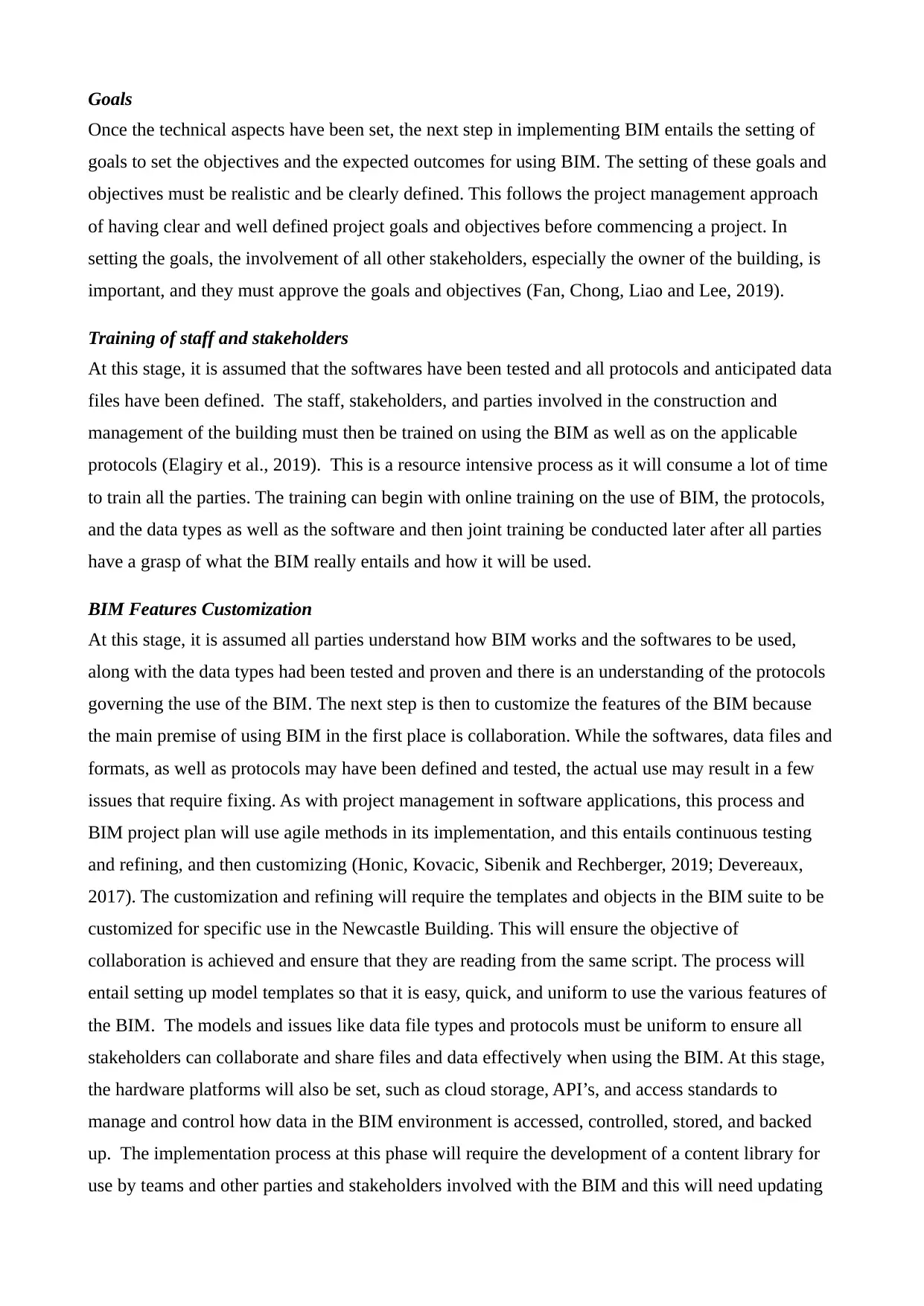
Goals
Once the technical aspects have been set, the next step in implementing BIM entails the setting of
goals to set the objectives and the expected outcomes for using BIM. The setting of these goals and
objectives must be realistic and be clearly defined. This follows the project management approach
of having clear and well defined project goals and objectives before commencing a project. In
setting the goals, the involvement of all other stakeholders, especially the owner of the building, is
important, and they must approve the goals and objectives (Fan, Chong, Liao and Lee, 2019).
Training of staff and stakeholders
At this stage, it is assumed that the softwares have been tested and all protocols and anticipated data
files have been defined. The staff, stakeholders, and parties involved in the construction and
management of the building must then be trained on using the BIM as well as on the applicable
protocols (Elagiry et al., 2019). This is a resource intensive process as it will consume a lot of time
to train all the parties. The training can begin with online training on the use of BIM, the protocols,
and the data types as well as the software and then joint training be conducted later after all parties
have a grasp of what the BIM really entails and how it will be used.
BIM Features Customization
At this stage, it is assumed all parties understand how BIM works and the softwares to be used,
along with the data types had been tested and proven and there is an understanding of the protocols
governing the use of the BIM. The next step is then to customize the features of the BIM because
the main premise of using BIM in the first place is collaboration. While the softwares, data files and
formats, as well as protocols may have been defined and tested, the actual use may result in a few
issues that require fixing. As with project management in software applications, this process and
BIM project plan will use agile methods in its implementation, and this entails continuous testing
and refining, and then customizing (Honic, Kovacic, Sibenik and Rechberger, 2019; Devereaux,
2017). The customization and refining will require the templates and objects in the BIM suite to be
customized for specific use in the Newcastle Building. This will ensure the objective of
collaboration is achieved and ensure that they are reading from the same script. The process will
entail setting up model templates so that it is easy, quick, and uniform to use the various features of
the BIM. The models and issues like data file types and protocols must be uniform to ensure all
stakeholders can collaborate and share files and data effectively when using the BIM. At this stage,
the hardware platforms will also be set, such as cloud storage, API’s, and access standards to
manage and control how data in the BIM environment is accessed, controlled, stored, and backed
up. The implementation process at this phase will require the development of a content library for
use by teams and other parties and stakeholders involved with the BIM and this will need updating
Once the technical aspects have been set, the next step in implementing BIM entails the setting of
goals to set the objectives and the expected outcomes for using BIM. The setting of these goals and
objectives must be realistic and be clearly defined. This follows the project management approach
of having clear and well defined project goals and objectives before commencing a project. In
setting the goals, the involvement of all other stakeholders, especially the owner of the building, is
important, and they must approve the goals and objectives (Fan, Chong, Liao and Lee, 2019).
Training of staff and stakeholders
At this stage, it is assumed that the softwares have been tested and all protocols and anticipated data
files have been defined. The staff, stakeholders, and parties involved in the construction and
management of the building must then be trained on using the BIM as well as on the applicable
protocols (Elagiry et al., 2019). This is a resource intensive process as it will consume a lot of time
to train all the parties. The training can begin with online training on the use of BIM, the protocols,
and the data types as well as the software and then joint training be conducted later after all parties
have a grasp of what the BIM really entails and how it will be used.
BIM Features Customization
At this stage, it is assumed all parties understand how BIM works and the softwares to be used,
along with the data types had been tested and proven and there is an understanding of the protocols
governing the use of the BIM. The next step is then to customize the features of the BIM because
the main premise of using BIM in the first place is collaboration. While the softwares, data files and
formats, as well as protocols may have been defined and tested, the actual use may result in a few
issues that require fixing. As with project management in software applications, this process and
BIM project plan will use agile methods in its implementation, and this entails continuous testing
and refining, and then customizing (Honic, Kovacic, Sibenik and Rechberger, 2019; Devereaux,
2017). The customization and refining will require the templates and objects in the BIM suite to be
customized for specific use in the Newcastle Building. This will ensure the objective of
collaboration is achieved and ensure that they are reading from the same script. The process will
entail setting up model templates so that it is easy, quick, and uniform to use the various features of
the BIM. The models and issues like data file types and protocols must be uniform to ensure all
stakeholders can collaborate and share files and data effectively when using the BIM. At this stage,
the hardware platforms will also be set, such as cloud storage, API’s, and access standards to
manage and control how data in the BIM environment is accessed, controlled, stored, and backed
up. The implementation process at this phase will require the development of a content library for
use by teams and other parties and stakeholders involved with the BIM and this will need updating
⊘ This is a preview!⊘
Do you want full access?
Subscribe today to unlock all pages.

Trusted by 1+ million students worldwide
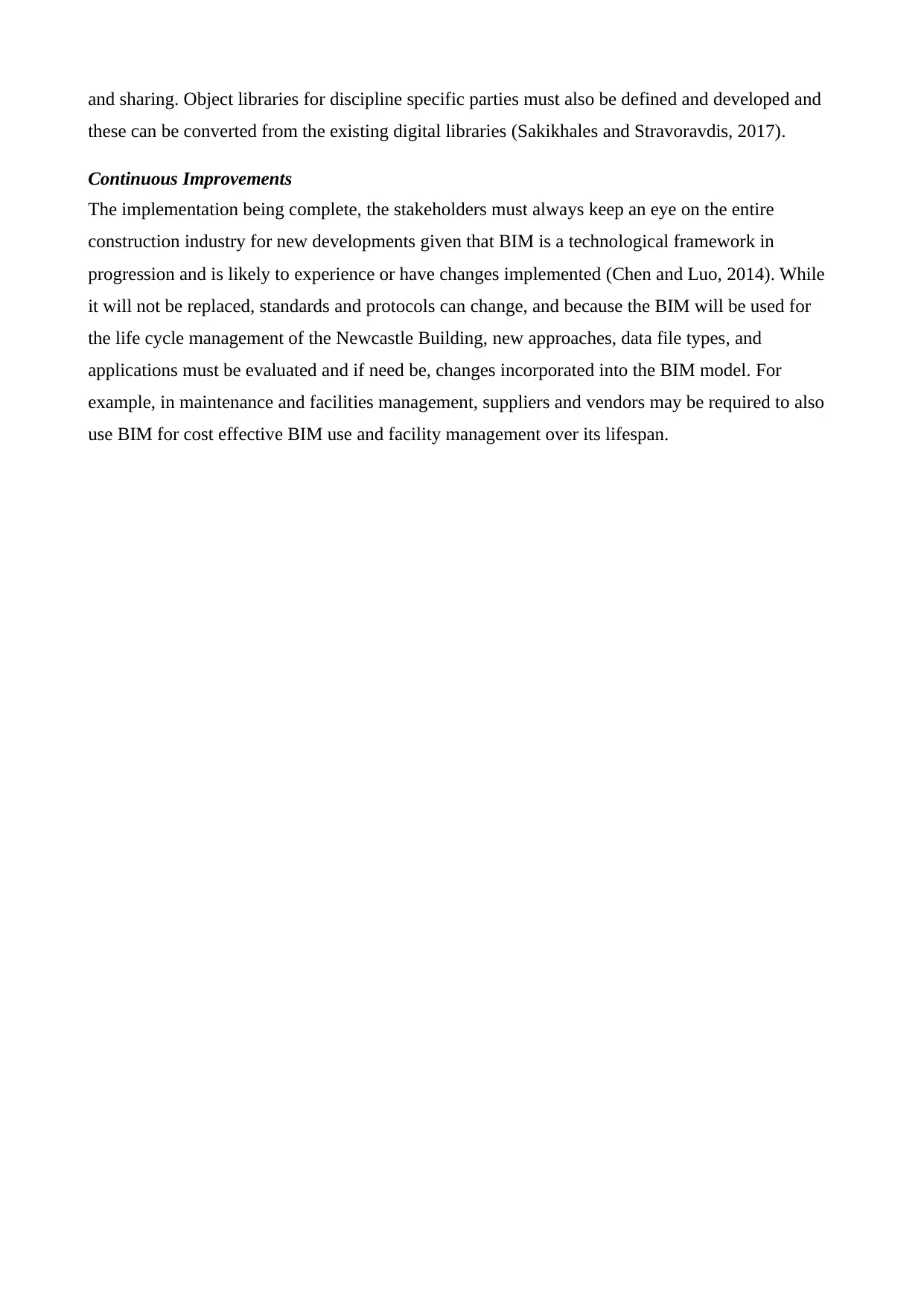
and sharing. Object libraries for discipline specific parties must also be defined and developed and
these can be converted from the existing digital libraries (Sakikhales and Stravoravdis, 2017).
Continuous Improvements
The implementation being complete, the stakeholders must always keep an eye on the entire
construction industry for new developments given that BIM is a technological framework in
progression and is likely to experience or have changes implemented (Chen and Luo, 2014). While
it will not be replaced, standards and protocols can change, and because the BIM will be used for
the life cycle management of the Newcastle Building, new approaches, data file types, and
applications must be evaluated and if need be, changes incorporated into the BIM model. For
example, in maintenance and facilities management, suppliers and vendors may be required to also
use BIM for cost effective BIM use and facility management over its lifespan.
these can be converted from the existing digital libraries (Sakikhales and Stravoravdis, 2017).
Continuous Improvements
The implementation being complete, the stakeholders must always keep an eye on the entire
construction industry for new developments given that BIM is a technological framework in
progression and is likely to experience or have changes implemented (Chen and Luo, 2014). While
it will not be replaced, standards and protocols can change, and because the BIM will be used for
the life cycle management of the Newcastle Building, new approaches, data file types, and
applications must be evaluated and if need be, changes incorporated into the BIM model. For
example, in maintenance and facilities management, suppliers and vendors may be required to also
use BIM for cost effective BIM use and facility management over its lifespan.
Paraphrase This Document
Need a fresh take? Get an instant paraphrase of this document with our AI Paraphraser
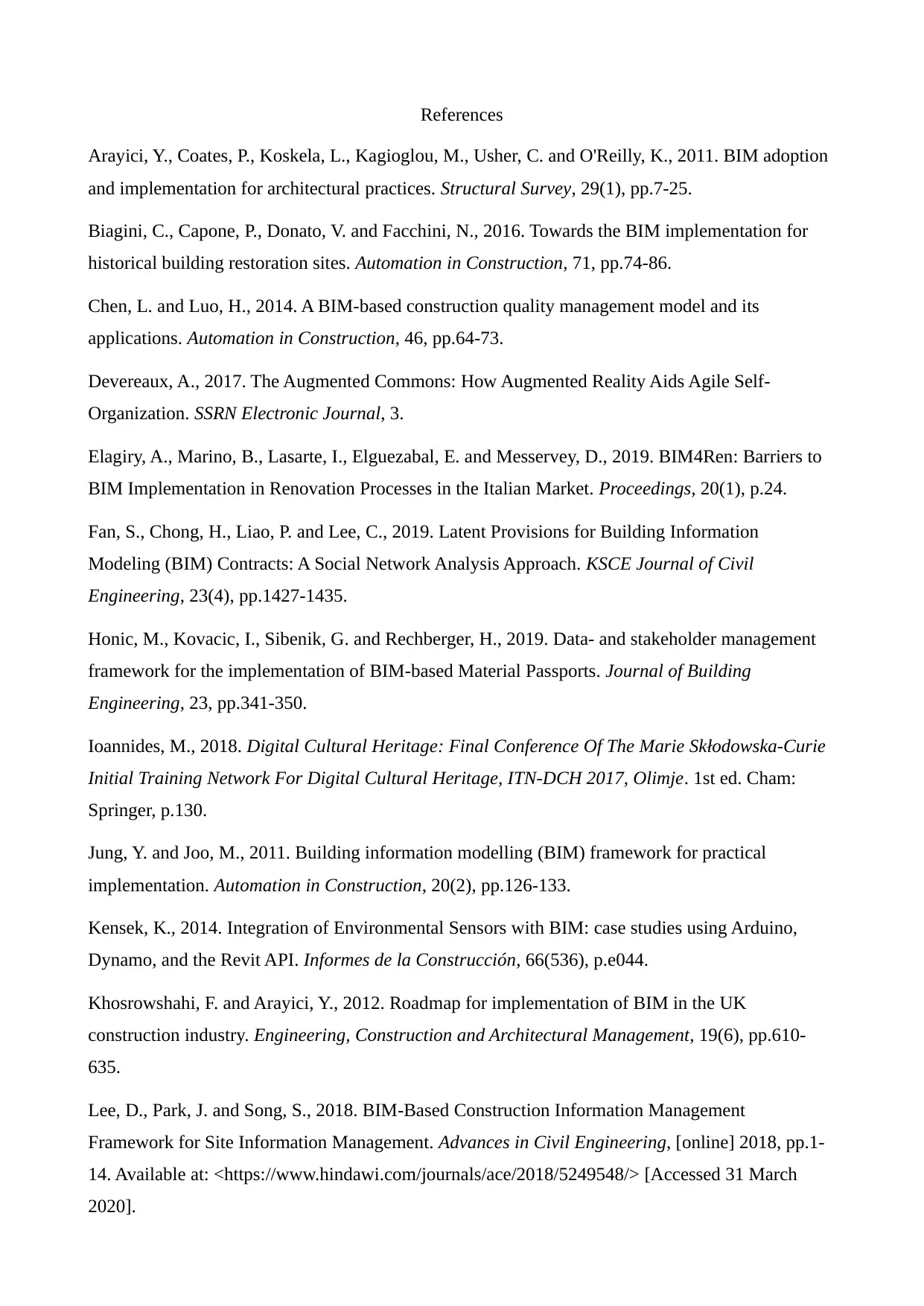
References
Arayici, Y., Coates, P., Koskela, L., Kagioglou, M., Usher, C. and O'Reilly, K., 2011. BIM adoption
and implementation for architectural practices. Structural Survey, 29(1), pp.7-25.
Biagini, C., Capone, P., Donato, V. and Facchini, N., 2016. Towards the BIM implementation for
historical building restoration sites. Automation in Construction, 71, pp.74-86.
Chen, L. and Luo, H., 2014. A BIM-based construction quality management model and its
applications. Automation in Construction, 46, pp.64-73.
Devereaux, A., 2017. The Augmented Commons: How Augmented Reality Aids Agile Self-
Organization. SSRN Electronic Journal, 3.
Elagiry, A., Marino, B., Lasarte, I., Elguezabal, E. and Messervey, D., 2019. BIM4Ren: Barriers to
BIM Implementation in Renovation Processes in the Italian Market. Proceedings, 20(1), p.24.
Fan, S., Chong, H., Liao, P. and Lee, C., 2019. Latent Provisions for Building Information
Modeling (BIM) Contracts: A Social Network Analysis Approach. KSCE Journal of Civil
Engineering, 23(4), pp.1427-1435.
Honic, M., Kovacic, I., Sibenik, G. and Rechberger, H., 2019. Data- and stakeholder management
framework for the implementation of BIM-based Material Passports. Journal of Building
Engineering, 23, pp.341-350.
Ioannides, M., 2018. Digital Cultural Heritage: Final Conference Of The Marie Skłodowska-Curie
Initial Training Network For Digital Cultural Heritage, ITN-DCH 2017, Olimje. 1st ed. Cham:
Springer, p.130.
Jung, Y. and Joo, M., 2011. Building information modelling (BIM) framework for practical
implementation. Automation in Construction, 20(2), pp.126-133.
Kensek, K., 2014. Integration of Environmental Sensors with BIM: case studies using Arduino,
Dynamo, and the Revit API. Informes de la Construcción, 66(536), p.e044.
Khosrowshahi, F. and Arayici, Y., 2012. Roadmap for implementation of BIM in the UK
construction industry. Engineering, Construction and Architectural Management, 19(6), pp.610-
635.
Lee, D., Park, J. and Song, S., 2018. BIM-Based Construction Information Management
Framework for Site Information Management. Advances in Civil Engineering, [online] 2018, pp.1-
14. Available at: <https://www.hindawi.com/journals/ace/2018/5249548/> [Accessed 31 March
2020].
Arayici, Y., Coates, P., Koskela, L., Kagioglou, M., Usher, C. and O'Reilly, K., 2011. BIM adoption
and implementation for architectural practices. Structural Survey, 29(1), pp.7-25.
Biagini, C., Capone, P., Donato, V. and Facchini, N., 2016. Towards the BIM implementation for
historical building restoration sites. Automation in Construction, 71, pp.74-86.
Chen, L. and Luo, H., 2014. A BIM-based construction quality management model and its
applications. Automation in Construction, 46, pp.64-73.
Devereaux, A., 2017. The Augmented Commons: How Augmented Reality Aids Agile Self-
Organization. SSRN Electronic Journal, 3.
Elagiry, A., Marino, B., Lasarte, I., Elguezabal, E. and Messervey, D., 2019. BIM4Ren: Barriers to
BIM Implementation in Renovation Processes in the Italian Market. Proceedings, 20(1), p.24.
Fan, S., Chong, H., Liao, P. and Lee, C., 2019. Latent Provisions for Building Information
Modeling (BIM) Contracts: A Social Network Analysis Approach. KSCE Journal of Civil
Engineering, 23(4), pp.1427-1435.
Honic, M., Kovacic, I., Sibenik, G. and Rechberger, H., 2019. Data- and stakeholder management
framework for the implementation of BIM-based Material Passports. Journal of Building
Engineering, 23, pp.341-350.
Ioannides, M., 2018. Digital Cultural Heritage: Final Conference Of The Marie Skłodowska-Curie
Initial Training Network For Digital Cultural Heritage, ITN-DCH 2017, Olimje. 1st ed. Cham:
Springer, p.130.
Jung, Y. and Joo, M., 2011. Building information modelling (BIM) framework for practical
implementation. Automation in Construction, 20(2), pp.126-133.
Kensek, K., 2014. Integration of Environmental Sensors with BIM: case studies using Arduino,
Dynamo, and the Revit API. Informes de la Construcción, 66(536), p.e044.
Khosrowshahi, F. and Arayici, Y., 2012. Roadmap for implementation of BIM in the UK
construction industry. Engineering, Construction and Architectural Management, 19(6), pp.610-
635.
Lee, D., Park, J. and Song, S., 2018. BIM-Based Construction Information Management
Framework for Site Information Management. Advances in Civil Engineering, [online] 2018, pp.1-
14. Available at: <https://www.hindawi.com/journals/ace/2018/5249548/> [Accessed 31 March
2020].
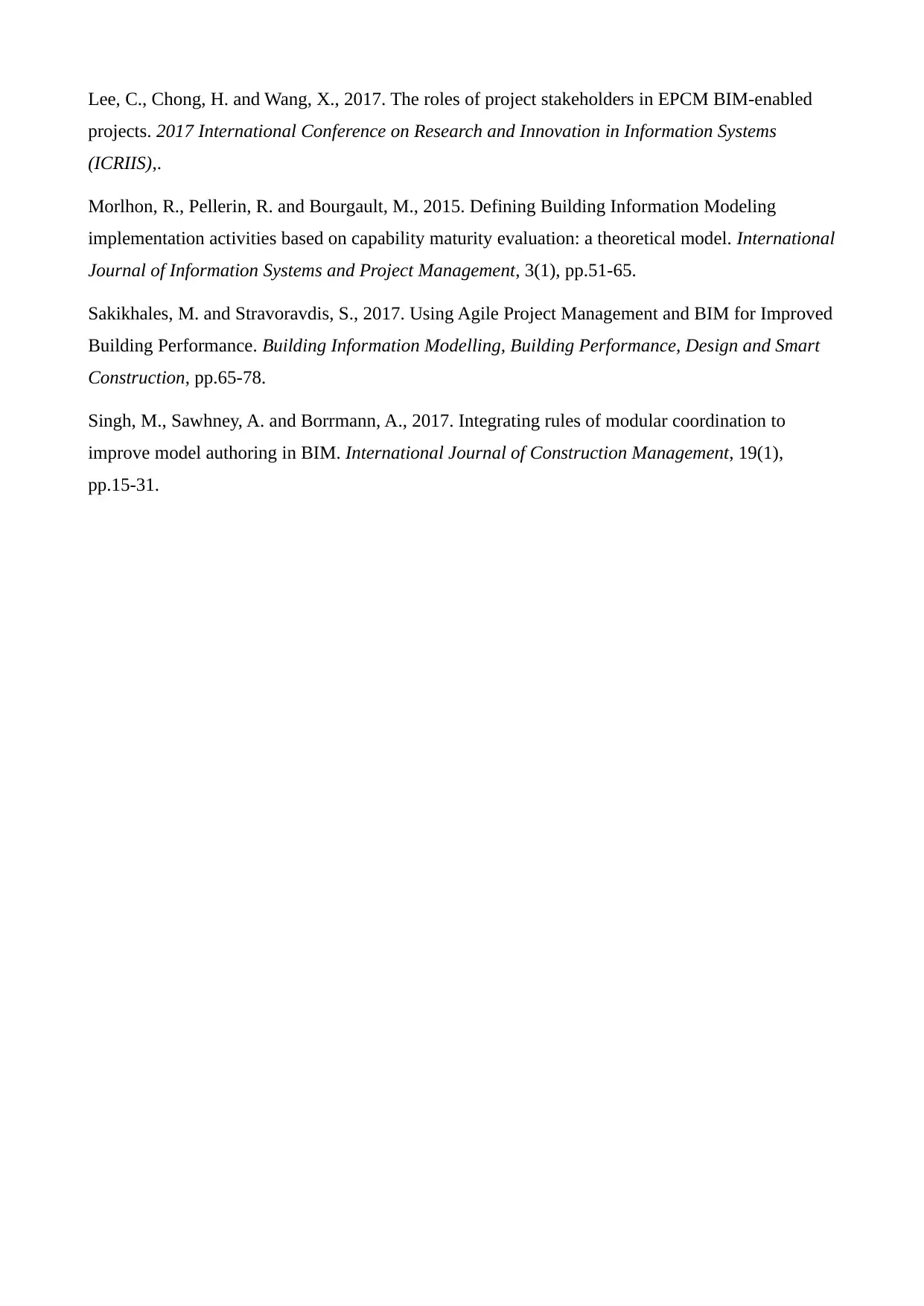
Lee, C., Chong, H. and Wang, X., 2017. The roles of project stakeholders in EPCM BIM-enabled
projects. 2017 International Conference on Research and Innovation in Information Systems
(ICRIIS),.
Morlhon, R., Pellerin, R. and Bourgault, M., 2015. Defining Building Information Modeling
implementation activities based on capability maturity evaluation: a theoretical model. International
Journal of Information Systems and Project Management, 3(1), pp.51-65.
Sakikhales, M. and Stravoravdis, S., 2017. Using Agile Project Management and BIM for Improved
Building Performance. Building Information Modelling, Building Performance, Design and Smart
Construction, pp.65-78.
Singh, M., Sawhney, A. and Borrmann, A., 2017. Integrating rules of modular coordination to
improve model authoring in BIM. International Journal of Construction Management, 19(1),
pp.15-31.
projects. 2017 International Conference on Research and Innovation in Information Systems
(ICRIIS),.
Morlhon, R., Pellerin, R. and Bourgault, M., 2015. Defining Building Information Modeling
implementation activities based on capability maturity evaluation: a theoretical model. International
Journal of Information Systems and Project Management, 3(1), pp.51-65.
Sakikhales, M. and Stravoravdis, S., 2017. Using Agile Project Management and BIM for Improved
Building Performance. Building Information Modelling, Building Performance, Design and Smart
Construction, pp.65-78.
Singh, M., Sawhney, A. and Borrmann, A., 2017. Integrating rules of modular coordination to
improve model authoring in BIM. International Journal of Construction Management, 19(1),
pp.15-31.
⊘ This is a preview!⊘
Do you want full access?
Subscribe today to unlock all pages.

Trusted by 1+ million students worldwide
1 out of 9
Related Documents
Your All-in-One AI-Powered Toolkit for Academic Success.
+13062052269
info@desklib.com
Available 24*7 on WhatsApp / Email
![[object Object]](/_next/static/media/star-bottom.7253800d.svg)
Unlock your academic potential
Copyright © 2020–2025 A2Z Services. All Rights Reserved. Developed and managed by ZUCOL.





